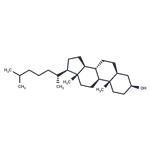Cholestanol is a cholesterol metabolite formed by oxidation and an intermediate in the biosynthesis of chenodeoxycholic acid . Cholestanol (10 μg/ml) induces apoptosis in cornea and lens epithelial cells and increases the activity of IL-1β converting enzyme (ICE) and CPP32 proteases. Dietary administration of 1% cholestanol to mice increases serum and liver cholestanol levels and leads to corneal opacities and gallstones and in rats it leads to cholestanol deposition in the cerebellum. Cholestanol levels are increased in plasma of patients with cerebrotendinous xanthomatosis (CTX), a disease characterized by a deficiency in the mitochondrial enzyme sterol 27-hydrolylase (CYP27A1) that leads to progressive neurological symptoms.
5alpha-Cholestan-3beta-ol is used as a standard in lipid analysis using HPLC. It acts as a derivitized steroid compound. It is used in agrochemical, pharmaceutical and dyestuff field .
5α-Cholestan-3β-ol is a carbon stanol formed from biohydrogenation of Cholesterol (C432501) in the gut. Studies have also examined the conversion of 5α-Cholestan-3β-ol catalyzed by 3-β-hydroxysteroid
dehydrogenase of rat liver.
ChEBI: A cholestanoid that is (5alpha)-cholestane substituted by a beta-hydroxy group at position 3.
Cholestanol is a 5α-dihydro derivative of cholesterol. It acts as a marker for cholesterol absorption. Cholestanol is a steroid with 27 carbon atoms.
5α-Cholestan-3β-ol is derived from cholesterol by the action of intestinal microorganisms. It is known to induce the formation of gall stones in rabbits in the presence of sodium ions.
Purify 5--cholestan-3-ol via acetylation, crystallisation and de-acetylation, then recrystallisation from EtOH or slightly aqueous EtOH, or MeOH. Its solubility is: 0.5% (MeOH) and 1% (EtOH) at 25o. [Mizutani & Whitten J Am Chem Soc 107 3621 1985.] The acetate has m 114-115o from EtOAc/MeOH and, [] D 20 +13o (c 2, CHCl3). [Bruce & Ralls Org Synth Col Vol II 191 1943, Beilstein 6 IV 3577.]


